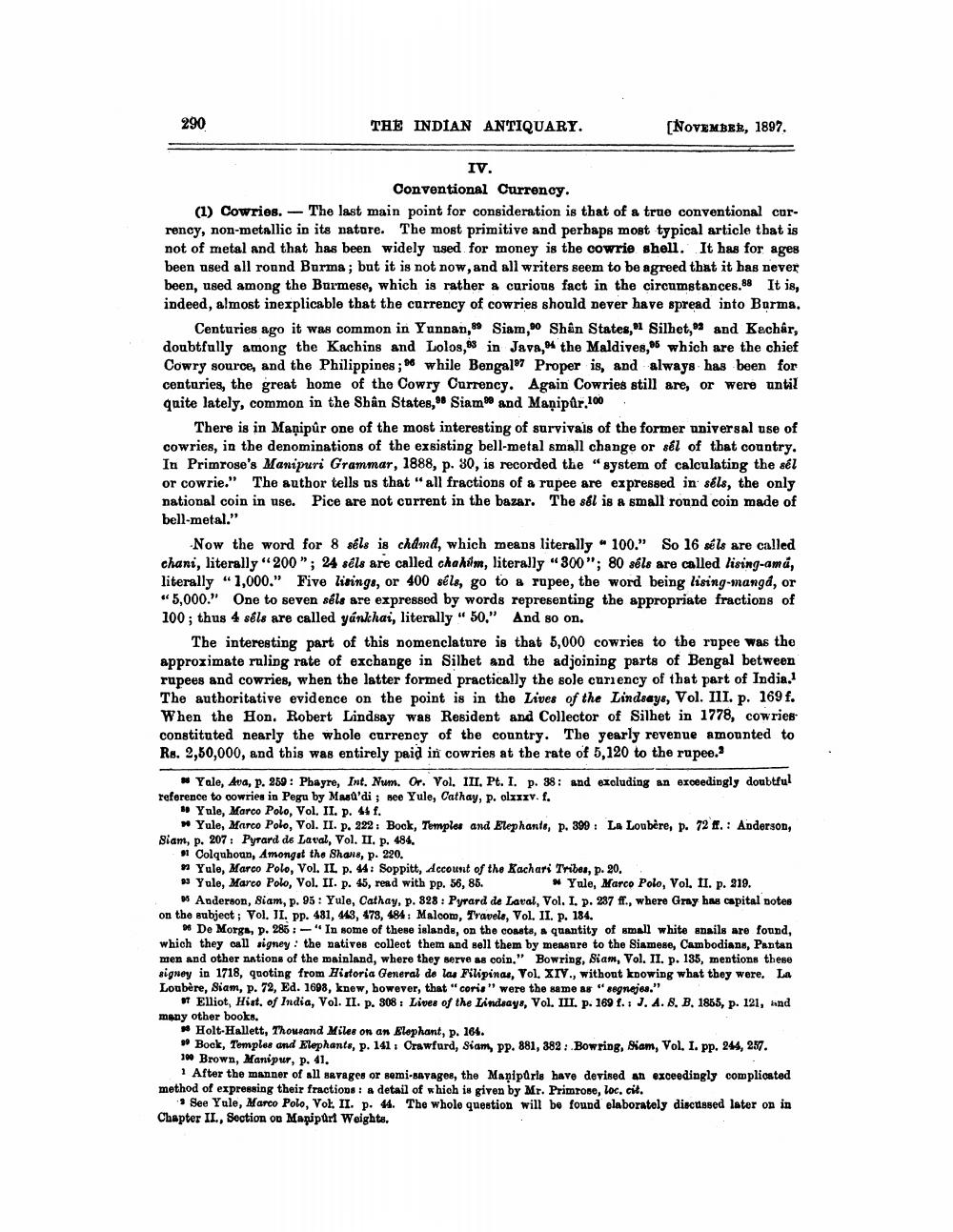________________
290
THE INDIAN ANTIQUARY.
(NOVEMBER, 1897.
IV.
Conventional Currency. (1) Cowries. - The last main point for consideration is that of a true conventional corrency, non-metallic in its nature. The most primitive and perhaps most typical article that is not of metal and that has been widely used for money is the cowrie shell. It has for ages been used all round Burma; but it is not now, and all writers seem to be agreed that it has never been, used among the Burmese, which is rather a curious fact in the circumstances.88 It is, indeed, almost inexplicable that the currency of cowries should never have spread into Borma,
Centuries ago it was common in Yunnan, Siam,oo Shân States," Silhet,” and Kachår, doubtfully among the Kachins and Lolos, es in Java, the Maldives, which are the chief Cowry source, and the Philippines ; 96 while Bengal97 Proper is, and always has been for centuries, the great home of the Cowry Currency. Again Cowries still are, or were until quite lately, common in the Shân States, * Siam and Manipur.100
There is in Manipür one of the most interesting of survivals of the former universal use of cowries, in the denominations of the exsisting bell-metal small change or sel of that country. In Primrose's Manipuri Grammar, 1888, p. 30, is recorded the "system of calculating the sél or cowrie." The author tells us that "all fractions of a rupee are expressed in séls, the only national coin in use. Pice are not current in the bazar. The sel is a small round coin made of bell-metal."
Now the word for 8 sels is chand, which means literally " 100." So 16 séls are called chani, literally "200"; 24 sdls are called chahim, literally "300"; 80 s6ls are called lising-ama, literally "1,000.” Five lisings, or 400 séls, go to a ropee, the word being lising-manga, or “5,000." One to seven séle are expressed by words representing the appropriate fractions of 100; thus 4 s@ls are called yánkhai, literally " 50." And so on.
The interesting part of this nomenclature is that 5,000 cowries to the rupee was the approximate ruling rate of exchange in Silbet and the adjoining parts of Bengal between rupees and cowries, when the latter formed practically the sole cariency of that part of India. The authoritative evidence on the point is in the Lives of the Lindsays, Vol. III. p. 169 f. When the Hon. Robert Lindsay was Resident and Collector of Silhet in 1778, cowries constituted nearly the whole currency of the country. The yearly revenue amounted to Rs. 2,50,000, and this was entirely paid in cowries at the rate of 5,120 to the rupee.
# Yale, Ava, p. 269: Pbayre, Int. Num. Or. Vol. III, Pt. I. p. 38: and excluding an exceedingly doubtful reference to cowries in Pegu by Masu'di ; see Yule, Cathay, P. OLIIV. f.
» Yule, Marco Polo, Vol. II. p. 44 f.
» Yule, Marco Polo, Vol. II. p. 222: Bock, Temples and Elephants, p. 390 : La Loubère, p. 72 f.: Anderson, Siam, p. 207: Pyrard de Laval, Vol. II, p. 484. 91 Colquhoun, Amongst the Shans, p. 220.
Yule, Marco Polo, Vol. IL p. 44: Soppitt, Account of the Kachari Tribes, p. 20. Yule, Marco Polo, Vol. II. p. 45, read with pp. 56, 85.
Yule, Marco Polo, Vol. II. p. 319. » Anderson, Siam, p. 95: Yule, Cathay, p. 828: Pyrard de Laval, Vol. I. p. 237 ff., where Gray has capital notes on the subject; Vol. II. pp. 481, 443, 479, 484: Malcom, Travels, Vol. II. p. 184.
* De Morgs, p. 285:-"In some of these islands, on the coasts, a quantity of small white snails are found, which they call signey : the nativos collect them and sell them by measure to the Siamese, Cambodians, Pantan men and other nations of the mainland, where they serve as coin," Bowring, Siam, Vol. II. p. 185, mentions these signey in 1718, quoting from Historia General de las Filipinas, Vol. XIV., withont knowing what they were. La Loubère, Siam, p. 72, Ed. 1698, knew, however, that "coris" were the same as "segnejes."
Elliot, Hist. of India, Vol. II. p. 308. Lives of the Lindsays, Vol. III. p. 169 1. J. 4.8. B. 1855, p. 121, and many other books.
# Holt-Hallett, Thousand Miles on an Elephant, p. 164.
Bock, Temples and Elephants, p. 141. Orawfurd, Siam, pp. 881, 382 : Bowring, Siam, Vol. I. pp. 244, 237. 100 Brown, Manipur, p. 41.
1 After the manner of all savages or somi-savages, the Manipurls have devined an exceedingly complicated method of expressing their fractions : a detail of which is given by Mr. Primrose, loc. cit.
* See Yule, Marco Polo, Vol. II. p. 44. The whole question will be found olaborately discussed later on in Chapter II., Section on Mapipuri Weights.




